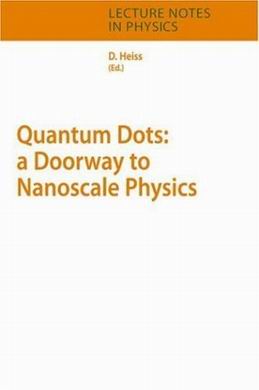اليكم هذا الكتاب المهم والمفيد في موضوع الميكانيك الكمي الذي يتعامل مع المواضيع الكمية ضمن الابعاد النانوية
«Quantum Dots: A Doorway to Nanoscale Physics»

W. D. Heiss (Editor), «Quantum Dots: A Doorway to Nanoscale Physics»
ISBN: 3540242368 | Publisher: Springer | Publication Date: 2005-04-01 | Number Of Pages: 188 | PDF | 3 MB
وعلى الرابط
http://rapidshare.com/files/916909/QuDots_DoorNanoPhysics_muya.rar
«Quantum Dots: A Doorway to Nanoscale Physics»

W. D. Heiss (Editor), «Quantum Dots: A Doorway to Nanoscale Physics»
ISBN: 3540242368 | Publisher: Springer | Publication Date: 2005-04-01 | Number Of Pages: 188 | PDF | 3 MB
Book Description
Quantum dots, often denoted artificial atoms, are the exquisite tools by which quantum behavior can be probed on a scale appreciably larger than the atomic scale, that is on the nanometer scale. In this way, the physics of the devices is closer to classical physics than that of atomic physics but they are still sufficiently small to clearly exhibit quantum phenomena. The present volume is devoted to an introduction to some of these fascinating aspects, addressing in particular graduate students and young researchers in the field. In the first lecture by R. Shankar, the general theoretical aspects of Fermi liquids are addressed, in particular the renormalization group approach. This is then aptly applied to large quantum dots. A completely different approach is encountered in the second contribution by J.M. Elzerman et al., in that it is a thorough experimental expose of what can be done or expected in the study of small quantum dots. Here the emphasis lies on the electron spin to be used as a qubit. In the third lecture series by M. Pustilnik and Leonid I. Glazman, mechanisms of low-temperature electronic transport through a quantum dot – weakly coupled to two conducting leads – are reviewed. The fourth series of lectures, by C.W.J. Beenakker, deals with a very interesting aspect of nanophysics: a peculiar property of superconducting mirrors discovered by Andreev about forty years ago and still a challenge to experimental physicist
s.Quantum dots, often denoted artificial atoms, are the exquisite tools by which quantum behavior can be probed on a scale appreciably larger than the atomic scale, that is on the nanometer scale. In this way, the physics of the devices is closer to classical physics than that of atomic physics but they are still sufficiently small to clearly exhibit quantum phenomena. The present volume is devoted to an introduction to some of these fascinating aspects, addressing in particular graduate students and young researchers in the field. In the first lecture by R. Shankar, the general theoretical aspects of Fermi liquids are addressed, in particular the renormalization group approach. This is then aptly applied to large quantum dots. A completely different approach is encountered in the second contribution by J.M. Elzerman et al., in that it is a thorough experimental expose of what can be done or expected in the study of small quantum dots. Here the emphasis lies on the electron spin to be used as a qubit. In the third lecture series by M. Pustilnik and Leonid I. Glazman, mechanisms of low-temperature electronic transport through a quantum dot – weakly coupled to two conducting leads – are reviewed. The fourth series of lectures, by C.W.J. Beenakker, deals with a very interesting aspect of nanophysics: a peculiar property of superconducting mirrors discovered by Andreev about forty years ago and still a challenge to experimental physicist
وعلى الرابط
http://rapidshare.com/files/916909/QuDots_DoorNanoPhysics_muya.rar
